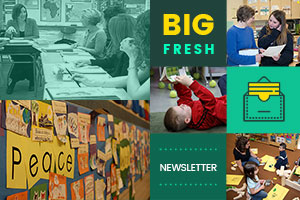Fashion changes, but style endures.
Coco Chanel
I recently went to a presentation on developing a company style guide. I thought it would be about Oxford commas, and was surprised and delighted to discover it was about thinking through how companies present themselves in ways beyond just having perfect spelling and grammar in their documents (which is important, no doubt).
The presenter walked the audience through a few questions to help us think through what style we want for our company and brand:
What is the most important thing I want people to know about my company without me having to tell them?
Why do you do what you do?
What promises do you keep?
I realized during the presentation that the teachers who impress me the most have a lot of style. Style is purposeful but appears to be effortless. Some teachers have oodles of comfy seating (at least as kids define it) and their classrooms are all about creating that slouchy, fun coffeehouse feel. Other teachers start the year with rooms that are almost bare by design. They are telling students, We will create and define this space together as we get to know each other.
As teachers clean out their rooms for summer and start daydreaming about design for the new year, changes are often on the level of deciding what to rearrange or discard. Why not begin by giving yourself the gift of some big beautiful questions:
What is the most important thing I want people to know about my classroom without me having to tell them?
Why do I do what I do?
What promises do I keep?
You may not completely rearrange your room or teaching plans with the answers to these questions. But if nothing else, they may help you recenter and recommit to what you value most.
This week we look at fostering more thoughtful reading and writing in middle schools. Plus more as always — enjoy!
Brenda Power
Founder, Choice Literacy
Free for All
[For sneak peeks at our upcoming features, quotes and extra links, follow Choice Literacy on Twitter: @ChoiceLiteracy or Facebook: http://www.facebook.com/ChoiceLiteracy or Pinterest: http://pinterest.com/choiceliteracy/]
Katie Baydo-Reed has to try, try, and try again to get high-quality writing and thinking from her eighth graders, but the effort builds independence and reflection:
http://www.choiceliteracy.com/articles-detail-view.php?id=1384
Katie Doherty works closely with a student who has an unusual request – he wants to take home an old basal anthology for “pleasure reading.” She puts a different text into his hands, and uses what she learns from the experience to design a lesson for her sixth-grade students:
http://www.choiceliteracy.com/articles-detail-view.php?id=863
Susan Curtis at Middleweb has compiled a treasure trove of closure activities for ending the year strong with young adolescents:
http://www.middleweb.com/7320/ideas-the-last-weeks-of-school/
For Members Only
Tara Barnett and Kate Mills use a know and wonder activity to encourage curiosity and independence as their seventh graders are beginning a new text:
http://www.choiceliteracy.com/articles-detail-view.php?id=2967
“Eat my shorts!” Christy Rush-Levine overhears a student comment in a literature group, and begins a quest to teach her students strategies for more appropriate and thoughtful conversations around texts:
http://www.choiceliteracy.com/articles-detail-view.php?id=2954
In this week’s video, Christy shows a group of three students how they can use a storyboard to help track thinking while reading:
http://www.choiceliteracy.com/articles-detail-view.php?id=2474
It’s May, and teachers everywhere are preparing for final assessments of students. Jennifer Schwanke explains why it might be time to rethink or even ditch some of those plans:
http://www.choiceliteracy.com/articles-detail-view.php?id=2965
In an encore video, Katie Baydo-Reed introduces the concept of annotation to her eighth-grade students:
http://www.choiceliteracy.com/articles-detail-view.php?id=1507
That’s all for this week!
Did someone send you a link to this newsletter? You can sign up for your own copy here:



